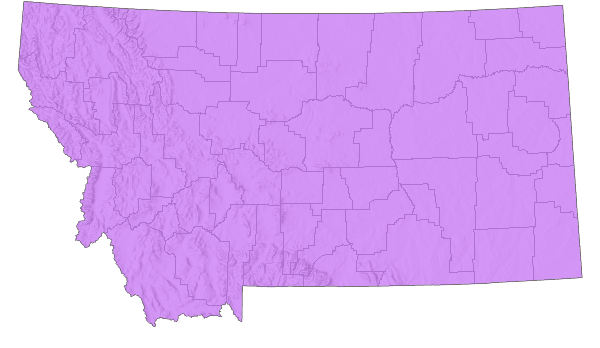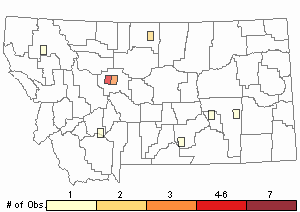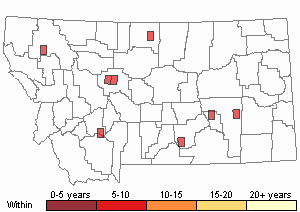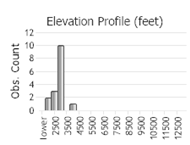View in other NatureServe Network Field Guides
NatureServe
Montana
Utah
Wyoming
Idaho
Wisconsin
British Columbia
South Carolina
Yukon
California
New York
Bronzed Tiger Beetle - Cicindela repanda
Other Names:
Riverside Tiger Beetle, Common Shore Tiger Beetle
Native Species
Global Rank:
G5
State Rank:
S5
Agency Status
USFWS:
USFS:
BLM:
External Links
General Description
The following comes from Wallis (1961), Kippenhan (1994), Knisley and Schultz (1997), Leonard and Bell (1999), Acorn (2001), Pearson et al (2015). Body length is 11-13 mm; reddish to bronzy-brown above with a short shoulder maculation connecting or nearly connecting with other maculations along the elytra margin, the front (shoulder) maculation shaped like the letter “C”. The underside of the abdomen is purple to blue-green, undersides of thorax are coppery, and covered with short white hairs. Constrictions at front and back of thorax are similar in width. Forehead is hairy, and labrum white with a single dark anterior tooth.
Phenology
Tiger beetle life cycles fit two general categories based on adult activity periods. “Spring-fall” beetles emerge as adults in late summer and fall, then overwinter in burrows before emerging again in spring when mature and ready to mate and lay eggs. The life cycle may take 1-4 years. “Summer” beetles emerge as adults in early summer, then mate and lay eggs before dying. The life cycle may take 1-2 years, possibly longer depending on latitude and elevation (Kippenhan 1994, Knisley and Schultz 1997, Leonard and Bell 1999). Adult Cicindela repanda a spring-fall species, in the southeastern U.S. January to June then August to November with stragglers in summer, in the northeast March to June then August to late September, in the west and northwest mid-March to early July then mid-August to early October (Carter 1989, Kippenhan 1994, Acorn 2001, Larochelle and Larivière 2001, Pearson et al. 2015). In Montana, adults are present at least mid-May to late September (Nate Kohler personal communication).
Diagnostic Characteristics
The following is taken largely from Kippenhan (1994), Acorn (2001), Pearson et al. (2015). This species is most similar in the west to the
Twelve-spotted Tiger Beetle (
C. duodecimguttata) and
Western Tiger Beetle (
C. oregona). Distinguished from
C. duodecimguttata by possessing a front (shoulder) maculation usually complete and connected (or only slightly separated) from the white line along the outer edge of the elytra, the pronotum (thorax) is about the same width in front and back. In
C. duodecimguttata, front maculation is usually broken and widely separated from outer edge of elytra, white marginal line along this edge is usually absent, and pronotum is trapezoidal in shape with front wider than back. The pronotum of
C. oregona is also trapezoidal in shape (wider at front than back), the front (shoulder) maculation consistently reduced to two spots, not in the shape of the letter “C” as with
C. repanda.
Species Range
Montana Range
Range Descriptions

 Native
Native
Range Comments
Cicindela repanda is one of the most common and widespread species, present across the eastern 3/4 of the United States and southern Canada, typically associated with sandy lake and river shores and ocean beaches as well as wet roadside ditches. From southern British Columbia to Newfoundland, south to Oregon, eastern Utah and Arizona, southern New Mexico and Texas, throughout the Midwest and eastern US to Florida and the Gulf of Mexico (Wallis 1961, Knisley and Schultz 1997, Leonard and Bell 1999, Acorn 2001, Pearson et al. 2015). In Montana, present across the state except the extreme northwest.
Observations in Montana Natural Heritage Program Database
Number of Observations: 27
(Click on the following maps and charts to see full sized version)
Map Help and Descriptions
Relative Density

Recency



 (Observations spanning multiple months or years are excluded from time charts)
(Observations spanning multiple months or years are excluded from time charts)
Migration
Non-migratory but capable of dispersal. When wings fully developed (macropterous), it is a good flier, fast runner, and early to colonize disturbed sites (Larochelle and Larivière 2001).
Habitat
Adult and larval tiger beetle habitat essentially identical, the larvae live in soil burrows (Knisley and Schultz 1997). Across the range Cicindela repanda is usually found near water, prefers sandy and muddy riverbanks, lake shores, stream banks, sand bars, sandy roads and sand dunes near water, wet fields, road and railroad cuts, coastal beaches, and open saline ground (Vaurie 1950, Wallis 1961, Hooper 1969, Kippenhan 1994, Knisley and Schultz 1997, Leonard and Bell 1999, Acorn 2001, Larochelle and Larivière 2001, Kritsky and Smith 2005). In Montana, habitat poorly described but includes lake and river shores, fishing access sites, sand hills, blowouts, river sandbars, and creek banks, to at least 4320 ft (1317 m) elevation (Nate Kohler personal communication).
Food Habits
Larval and adult tiger beetles are predaceous. In general, both feed considerably on ants (Wallis 1961, Knisley and Schultz 1997). Diet of adult Cicindela repanda in the field includes ants, beetles (carabids, staphylinids, weevils, halictids), acridid grasshoppers, caterpillars, flies (sarcophagids, tipulids), springtails, worms, spiders, sassafras and pokeweed fruits. Items in captivity include crushed snails, tadpoles, dead fish, lean meat, and fruit (Larochelle and Larivière 2001). One of the few tiger beetle species documented to be an opportunistic frugivore (Hill and Knisley 1992, Knisley and Schultz 1997). Larval foods include acridid grasshoppers in the field, lean meat in captivity (Larochelle and Larivière 2001).
Ecology
Larval tiger beetles live in burrows and molt through three instars to pupation, which also occurs in the larval burrow. Adults make shallow burrows in soil for overnight protection, deeper burrows for overwintering. Adults are sensitive to heat and light and are most active during sunny conditions. Excessive heat during midday on sunny days drives adults to seek shelter among vegetation or in burrows (Wallis 1961, Knisley and Schultz 1997).
Cicindela repanda has a broad range of ecological tolerance (eurytopic). Larval burrows often in high densities, excavated in moist soil or sand (sometimes clay or mud), and sometimes mixed with humus. Leaves burrow for a moister locality when burrow gets too hot or dry. Larvae commonly attacked by a parasitoid fly (
Anthrax) (Larochelle and Larivière 2001, Pearson et al. 2015). Adults are diurnal and crepuscular, often gregarious, hide a short distance from water’s edge during night and on rainy, cloudy or cool days, in excavated holes 1.2-2.5 cm deep in sand or grass often close to edge of stone, wood, or under dead leaves. Predators across range include toads, frogs, and various birds (bluebirds, gulls, European Starling, American Kestrel, owls, flycatchers), moles, asilid (robber) flies, aeshnid dragonflies, lycosid spiders, and sundews (
Drosera). Other associated tiger beetle species include with
C. duodecimguttata,
C. hirticollis,
C.[= Ellipsoptera] nevadica,
C. oregona,
C.[= Cicindelidia] punctulate,
C. sexgutta, and
C. tranquebarica (Kippenhan 1994, Larochelle and Larivière 2001).
Reproductive Characteristics
The life cycle of
Cicindela repanda is mostly 2 years, 1 year in southeastern US (Knisley and Schultz 1997, Leonard and Bell 1999, Acorn 2001, Pearson et al. 2015). Mating occurs from May to July, copulation lasts about 3 minutes. Adult females oviposit from the surface during the day to depths of 5-10 mm. Eggs are yellow and 2 mm in length. Oviposition occurs in May and June in Illinois (Shelford 1908). Larval burrows are 7.5-15.0 cm in length at right angle to sloping surfaces, oblique to horizontal surfaces. Fresh adults (tenerals) emerge in July to October then overwinter and reach sexual maturity the following spring after hibernation. Interspecific copulations reported with
C. duodecimguttata,
C. oregona, and
C. sexgutta (Larochelle and Larivière 2001, Brust et al. 2012). No information for Montana.
Management
Not considered rare or in need of special conservation management (Knisley et al. 2014). River and lakeshore habitats benefit from disturbance that retains open conditions. C. repanda benefits in particular from the creation of dredge spoils following operations to maintain or clear ditch or canal channels. Exotic grasses, such as cheatgrass, could become a problem at local scales where they invade moist open habitats. Larval burrows could be impacted by trampling through livestock overgrazing or concentrations at water sources, but grazing at appropriate times and stocking levels could also be beneficial by keeping vegetation cover more open (Knisley 2011).
Stewardship Responsibility
References
- Literature Cited AboveLegend:
 View Online Publication
View Online Publication Acorn, J. 2001. Tiger beetles of Alberta: killers on the clay, stalkers on the sand. The University of Alberta Press, Edmonton, Alberta. 120 p.
Acorn, J. 2001. Tiger beetles of Alberta: killers on the clay, stalkers on the sand. The University of Alberta Press, Edmonton, Alberta. 120 p. Brust, M.L., C.B. Knisley, S.M. Spomer, and K. Miwa. 2012b. Observations of oviposition behavior among North American tiger beetle (Coleoptera: Carabidae: Cicindelinae) species and notes on mass rearing. The Coleopterists Bulletin 66(4):309-314.
Brust, M.L., C.B. Knisley, S.M. Spomer, and K. Miwa. 2012b. Observations of oviposition behavior among North American tiger beetle (Coleoptera: Carabidae: Cicindelinae) species and notes on mass rearing. The Coleopterists Bulletin 66(4):309-314. Carter, M. R. 1989. The biology and ecology of the tiger beetles (Coleoptera: Cicindelidae) of Nebraska. Transactions of the Nebraska Academy of Sciences XVII: 1-18.
Carter, M. R. 1989. The biology and ecology of the tiger beetles (Coleoptera: Cicindelidae) of Nebraska. Transactions of the Nebraska Academy of Sciences XVII: 1-18. Hill, J.M. and C.B. Knisley. 1992. Frugivory in the tiger beetle, Cicindela repanda (Coleoptera: Cicindelidae). The Coleopterists Bulletin 46(3):306-310.
Hill, J.M. and C.B. Knisley. 1992. Frugivory in the tiger beetle, Cicindela repanda (Coleoptera: Cicindelidae). The Coleopterists Bulletin 46(3):306-310. Hooper, R.R. 1969. A review of Saskatchewan tiger beetles. Cicindela 1(4):1-5.
Hooper, R.R. 1969. A review of Saskatchewan tiger beetles. Cicindela 1(4):1-5. Kippenhan, Michael G. 1994. The Tiger Beetles (Coleoptera: Cicindelidae) of Colorado. 1994. Transactions of the American Entomological Society 120(1):1-86.
Kippenhan, Michael G. 1994. The Tiger Beetles (Coleoptera: Cicindelidae) of Colorado. 1994. Transactions of the American Entomological Society 120(1):1-86. Knisley, C.B. 2011. Anthropogenic disturbances and rare tiger beetle habitats: benefits, risks, and implications for conservation. Terrestrial Arthropod Reviews 4:41-61.
Knisley, C.B. 2011. Anthropogenic disturbances and rare tiger beetle habitats: benefits, risks, and implications for conservation. Terrestrial Arthropod Reviews 4:41-61. Knisley, C.B., and T.D. Schultz. 1997. The biology of tiger beetles and a guide to the species of the south Atlantic states. Virginia Museum of Natural History Special Publication Number 5. 210 p.
Knisley, C.B., and T.D. Schultz. 1997. The biology of tiger beetles and a guide to the species of the south Atlantic states. Virginia Museum of Natural History Special Publication Number 5. 210 p. Knisley, C.B., M. Kippenhan, and D. Brzoska. 2014. Conservation status of United States tiger beetles. Terrestrial Arthropod Reviews 7:93-145.
Knisley, C.B., M. Kippenhan, and D. Brzoska. 2014. Conservation status of United States tiger beetles. Terrestrial Arthropod Reviews 7:93-145. Kohler, Nathan S. Excel spreadsheets of tiger beetle observations. 6 August 2022.
Kohler, Nathan S. Excel spreadsheets of tiger beetle observations. 6 August 2022. Kritsky, G. and J. Smith. 2005. Teddy's tigers: the Cicindelidae (Coleoptera) of Theodore Roosevelt National Park, North Dakota. Cicindela 37(1-2):1-16
Kritsky, G. and J. Smith. 2005. Teddy's tigers: the Cicindelidae (Coleoptera) of Theodore Roosevelt National Park, North Dakota. Cicindela 37(1-2):1-16 Larochelle, A and M Lariviere. 2001. Natural history of the tiger beetles of North America north of Mexico. Cicindela. 33:41-162.
Larochelle, A and M Lariviere. 2001. Natural history of the tiger beetles of North America north of Mexico. Cicindela. 33:41-162. Leonard, Jonathan G. and Ross T. Bell, 1999. Northeastern Tiger Beetles: a field guide to tiger beetles of New England and eastern Canada. Boca Raton, FL: CRC Press. 176 p.
Leonard, Jonathan G. and Ross T. Bell, 1999. Northeastern Tiger Beetles: a field guide to tiger beetles of New England and eastern Canada. Boca Raton, FL: CRC Press. 176 p. Pearson, D.L., C.B. Knisley, D.P. Duran, and C.J. Kazilek. 2015. A field guide to the tiger beetles of the United States and Canada, second edition. New York, NY: Oxford University Press. 251 p.
Pearson, D.L., C.B. Knisley, D.P. Duran, and C.J. Kazilek. 2015. A field guide to the tiger beetles of the United States and Canada, second edition. New York, NY: Oxford University Press. 251 p. Shelford, V.E. 1908. Life-histories and larval habits of the tiger beetles (Cicindelidae). The Journal of the Linnean Society 30:157-184.
Shelford, V.E. 1908. Life-histories and larval habits of the tiger beetles (Cicindelidae). The Journal of the Linnean Society 30:157-184. Vaurie, P. 1950. Notes on the habitats of some North American tiger beetles. Journal of the New York Entomological Society 58(3):143-153.
Vaurie, P. 1950. Notes on the habitats of some North American tiger beetles. Journal of the New York Entomological Society 58(3):143-153. Wallis, J.B. 1961. The Cicindelidae of Canada. Toronto, Ontario, Canada: University of Toronto Press. 74 p.
Wallis, J.B. 1961. The Cicindelidae of Canada. Toronto, Ontario, Canada: University of Toronto Press. 74 p.
- Additional ReferencesLegend:
 View Online Publication
View Online Publication
Do you know of a citation we're missing? Bousquet, Yves. 2012. Catalogue of Geadephaga (Coleoptera; Adephaga) of America north of Mexico. ZooKeys. 245:1-1722.
Bousquet, Yves. 2012. Catalogue of Geadephaga (Coleoptera; Adephaga) of America north of Mexico. ZooKeys. 245:1-1722. Criddle, N. 1907. Habits of some Manitoba 'tiger beetles' (Cicindela). Canadian Entomologist 39:105-114.
Criddle, N. 1907. Habits of some Manitoba 'tiger beetles' (Cicindela). Canadian Entomologist 39:105-114. Pearson, D.L., C.B. Knisley, and C.J. Kazilek. 2006. A field guide to the tiger beetles of the United States and Canada: identification, natural history, and distribution of the Cicindelidae. Oxford University Press, New York, New York. 227 pp.
Pearson, D.L., C.B. Knisley, and C.J. Kazilek. 2006. A field guide to the tiger beetles of the United States and Canada: identification, natural history, and distribution of the Cicindelidae. Oxford University Press, New York, New York. 227 pp.
- Web Search Engines for Articles on "Bronzed Tiger Beetle"
- Additional Sources of Information Related to "Insects"





